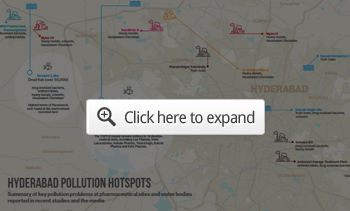Drug Companies Responsible for Severe Environmental Pollution
More Information
By Dr. Mercola
Environmental pollution is a tremendous concern, and the sources of toxic pollution are many. One source that has managed to skirt below the radar is the drug industry.1,2,3,4 In 2016, the nonprofit foundation Changing Markets issued a report on “Impacts of Pharmaceutical Pollution on Communities and Environment in India,”5 on behalf of Nordea Asset Management, a major investment firm in Sweden.
According to this report, the severe water pollution problem in India can be, to a significant extent, traced back to the generic drug industry. Between 2010 and 2015, the number of contaminated waterways in India more than doubled, and by 2015, more than half of the nation’s rivers were polluted. India’s low cost of manufacturing has lured a number of drug companies to set up shop, congregating in the city of Hyderabad and along the Andhra Pradesh coastline.
According to a recent economic survey by the Finance Ministry of India, Hyderabad’s drug industry accounts for nearly half of the country’s drug exports.6 “Outsourcing of production to the emerging markets, where labor is cheap, workforces skilled and environmental standards lax, has now become second nature for the pharmaceutical majors, many of which are based in the United States and Europe,” the report noted.
The report also stressed that there’s a disturbing lack of transparency within the drug industry about the origin of active ingredients and the finished drugs, and that while regulators “who could easily demand greater transparency from the drug industry, have so far shied away from taking action.”
New Report Calls Renewed Attention to India’s Pollution Crisis
In a follow-up report,7 the Changing Markets Foundation now calls renewed attention to the pollution crisis in Hyderabad, with a focus on heavy metal and other toxic waste pollution created by the “bulk drug” industry operating in India.
Based on visits to the area, interviews with experts and locals, and analysis of published research and media articles, the report concludes that drug companies in Hyderabad continue to “discharge untreated or inappropriately treated wastewater into the environment and that local and national authorities are failing to get the situation under control.”
In fact, in the two years since the publication of the first report, the situation in Hyderabad has deteriorated further. What’s worse, plans to expand drug production in the city, combined with a lack of regulations to control toxic waste emissions, makes for “a grim future” for local residents in the area, the report warns.
In addition to the release of untreated effluent, local media investigations have revealed the practice of illegal toxic waste dumping, where drug companies are discarding hazardous waste under the cover of night, using unmarked vehicles.8,9 Mass die-offs of fish have also made headlines, and the dead fish were found to contain toxic solvents used during the drug manufacturing process.
>>>>> Click Here <<<<<
Source: Changing Markets Foundation, Hyderabad’s Pharmaceutical Pollution Crisis
Water sampling near drug factories in the area, collected in September 2017, reveal significant amounts of heavy metals — including lead, mercury, copper, cadmium, vanadium, hexavalent chromium, nickel, zinc and arsenic — as well as toxic industrial solvents, are being released into the city’s waterways.
“In some cases, these were found to be present at extremely high concentrations, orders of magnitude higher than maximum regulatory limits or safe exposure levels, which points to substantial human and ecological risk potential,” the report states, adding “The mere presence of some of these substances is cause for alarm given their extreme toxicity.”
Antibiotic Production Poses Grave Risks
The report also highlights previous studies showing factories manufacturing antibiotics pose a grave risk by fueling antibiotic resistance in the environment. Antibiotic pollution is a problem not only in India, but also in China, Pakistan, Korea, Denmark, Norway and Croatia, and promotes the development of drug-resistant pathogens.
In November 2016, German researchers collected water samples from “the direct environment of bulk drug manufacturing facilities, the vicinity of two sewage treatment plants, the Musi River and habitats in Hyderabad and nearby villages.”10
Twenty-eight sampling sites were surveyed, and the water samples were analyzed for 25 anti-infective pharmaceuticals as well as multidrug-resistant pathogens and certain resistance genes. Disturbingly, all of the samples were contaminated with antimicrobials, including high concentrations of moxifloxacin, voriconazole and fluconazole. Area sewers also contained elevated concentrations of eight other antibiotics.
Some of the water samples contained antimicrobials at levels up to 5,500 times higher than the environmental regulation limit. What’s more, more than 95 percent of the samples also contained multidrug-resistant bacteria and fungi. The researchers called the contamination “unprecedented” and blamed it on “insufficient wastewater management by bulk drug manufacturing facilities, which seems to be associated with the selection and dissemination of carbapenemase-producing pathogens.”
Toxic Antibiotics Pollute India’s Waterways and Farmland
What happens is that during the drug manufacturing process, significant quantities of antibiotics are flushed out into wastewater, which then find its way into rivers, drinking water and farmland. The Patancheru water treatment plant, located near Hyderabad, receives 400,000 gallons of wastewater from 90 drug companies each day. All of this manufacturing effluent is combined with domestic wastewater, less than 25 percent of which actually undergoes treatment.
Swedish researchers, who have studied and published environmental reports about Hyderabad since 2007, have reported that some drug levels found in wastewater are higher than what is found in patients’ blood.11 The worst water contaminant detected was the antibiotic ciprofloxacin, which was found at a concentration high enough to give 44,000 people a full course of treatment.
Cipro is a fluoroquinolone antibiotic, a class of synthetic antibacterial drugs that directly inhibit bacterial DNA synthesis, and has been linked to permanent nerve damage in some patients. Due to their tremendous health risks, fluoroquinolones should be reserved for treating serious bacterial infections that will not respond to any other treatment. The idea that Cipro is being disseminated at those levels into the environment and people’s drinking water is disconcerting, to say the least.
Antibiotic Pollution Promotes Spread of Drug-Resistant Genes
Researchers have also confirmed that this wastewater is toxic to a number of organisms, and promotes drug-resistant genes. DNA samples taken downstream from drug manufacturing facilities reveal nearly 2 percent of the samples contain drug-resistant genes. Aside from direct ingestion, contaminated wastewater also finds its way onto crop fields via irrigation and sludge (biosolids) used as fertilizer.
In this way, drug-resistant genes are spread, shared and multiplied throughout the environment. A 2013 paper12 published in Environmental Health Perspectives addresses management options for reducing antibiotics and drug-resistant genes into the environment — such as safe disposal practices, wastewater and biosolid treatment, limiting agricultural and aquacultural use of antibiotics — and using alternatives to antibiotics whenever possible. But, so far, regulators and the industry itself have done virtually nothing.
Indian Drug Manufacturers May Lose European Supply Contracts
According to Changing Markets, Indian drug manufacturers who fail to clean up their act may soon lose their competitive advantage though. According to the report:13
“European NGOs have recently called for major procurement bodies, including the U.K.’s National Health Service, German health insurance companies, and French hospitals, to blacklist the worst-offending polluters and embed environmental criteria in all the contracts with pharmaceutical suppliers. Several of these organizations are now reviewing the situation. In Sweden, the country’s regions have come together and introduced environmental criteria and audits in their contracts.”
Sasja Beslik, who heads Nordea’s Group Sustainable Finance, also warned that “The pharmaceutical industry has to take action to tackle pollution at Indian factories supplying medicines to the global market,” adding that Nordea is willing to “continue the engagement with the pharma industry in order to find constructive and concrete solutions for these significant challenges that are impacting millions of people and the environment.”14 Changing Markets’ campaign manager Natasha Hurley also stressed that:15
“Multinational pharmaceutical companies which outsource API [active product ingredient] production to India to cut costs and maximize profits have a responsibility to take rapid action to put a stop to pollution in their supply chains.
Given the lack of transparency within the industry and the slow progress the global pharma giants have made on this to date, it is of paramount importance that regulators introduce environmental criteria that guard against such bad practices, both at national and international level.”
Pollution From Drug Manufacturing — A Supply Chain Problem That Must Be Tackled
According to the report, pollution from drug manufacturing has been “clearly exposed as a supply chain problem,” and the answer lies in holding drug companies responsible for their supply chains. While some have started taking steps in the right direction, “the industry and regulators are not moving fast enough to address the threat,” Changing Markets warns, saying that multinational drug companies that outsource production of active ingredients to India must step up and “take rapid action to end pollution within their supply chain.”
Regulatory agencies and medical agencies must also add environmental criteria to the good manufacturing practices standards, to prevent uncontrolled pollution within drug manufacturing. It’s a truly sad irony that millions of people in India are being poisoned by the very industry producing “lifesaving” medication for the rest of the world.
On a personal level, there’s not much you can do about this state of affairs. Governments and the drug industry need to address these problems head on, and hopefully Nordea’s push to hold drug companies accountable will have a marked effect.
Cleaning Up Your Own Household
That said, it’s important to remember that pollution is a global problem, and that pollutants don’t stay in any one area. Toxins and drug-resistant pathogens in India’s waterways spread far and wide. As noted in a 2008 report16 by the U.S. Centers for Disease Control and Prevention, multidrug-resistant E.coli bacteria have even been found in the Arctic; brought there by migrating birds!
So, no matter where you live, it would be wise to consider the purity of both your food and water. Also be mindful of not adding to the problem yourself. Never dispose of unused drugs by flushing them down the drain or toilet. It’s also inadvisable to throw them out in your garbage, as then they just end up in a landfill. For guidance on proper drug disposal, see this previous article.
Unfortunately, toxic biosolids may be used even in organic farming, and may be found in USDA 100 percent organic compost, mulch and potting soil for use in your own backyard. These products do not need to disclose the presence of biosolids, but some companies will list “milogranite” on the label, which means it contains toxic biosolids.
Your best alternative is to contact your local nursery and ask them if they use biosolids in their compost. Another alternative is to make your own, using a composting bin or wood chips for example. When it comes to buying organic food, the only way to find out if biosolids were used is to talk to the farmer.
Lastly, consider installing a high-quality water filtration system in your home, as drugs are a commonly occurring contaminant just about everywhere. The reason for this is because water treatment facilities are not equipped to filter these substances out. For more information and guidance on water filtration, see “How to Properly Filter Your Water.”
Source:: Mercola Health Articles




 Body Charge Nutrition is a premium nutritional supplement provider based in Western Canada offering only products and information that are of the highest quality and integrity. Through knowledge and personal experience, it is our goal to assist you with taking control of your health.
Body Charge Nutrition is a premium nutritional supplement provider based in Western Canada offering only products and information that are of the highest quality and integrity. Through knowledge and personal experience, it is our goal to assist you with taking control of your health.